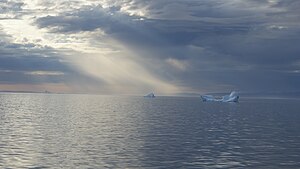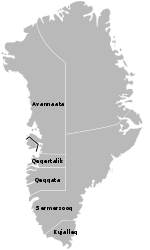| Disko Bay | |
|---|---|
| Diskobugten | |
| Qeqertarsuup tunua (Greenlandic) | |
 Icebergs in Disko Bay Icebergs in Disko Bay | |
 | |
| Location | Arctic |
| Coordinates | 69°00′N 52°00′W / 69.000°N 52.000°W / 69.000; -52.000 |
| Ocean/sea sources | Baffin Bay |
| Basin countries | Greenland |
| Settlements | Saqqaq, Ilulissat, Ilimanaq, Qasigiannguit, Ikamiut, Akunnaaq, Aasiaat, Kitsissuarsuit |
Disko Bay (Greenlandic: Qeqertarsuup tunua; Danish: Diskobugten) is a large bay on the western coast of Greenland. The bay constitutes a wide southeastern inlet of Baffin Bay.
Geography
Disko Bay
To the south the coastline is complicated with multiple waterways of skerries and small islands in the Aasiaat archipelago. Qasigiannguit and Ilimanaq are the main settlements in the southeastern inlet, just south of the outflow of Ilulissat Icefjord.
From the north the bay is bounded by Qeqertarsuaq (Disko Island), the largest island on the western coast. North of Ilulissat and west of Alluttoq Island the bay transforms into Sullorsuaq Strait separating Qeqertarsuaq from Nuussuaq Peninsula.
It is the largest open bay in western Greenland, measuring 150 kilometres (93 mi) north to south and 100 kilometres (62 mi) east to west. It has an average depth of 400 metres (1,300 ft) and average water temperature of 3.5 °C (38.3 °F), which in winter drops to −1.75 °C (28.85 °F) and then rises up to 12 °C (54 °F) in summer. This is changing, as the bay has been gradually warming up since 1997.
History
| This section possibly contains original research. Please improve it by verifying the claims made and adding inline citations. Statements consisting only of original research should be removed. (May 2010) (Learn how and when to remove this message) |
It is uncertain when the Inuit first started venturing into Disko Bay, but the Saqqaq were present there between 2400 and 900 BC.
Disko Bay has been an important location for centuries. Its coastline was first encountered by Europeans when Erik the Red started a settlement in 985 AD on the more habitable western coast of Greenland. The two settlements, called the Eastern and Western settlements, were sustenance economies that survived on animal husbandry and farming. Soon after the Western settlement was established, the Norsemen travelled up the coast during the summer thaw and discovered Disko Bay.
Their interest in this bay was due to its rich resources: walruses for ivory, seals for their pelts, and whales for a variety of materials. These products became the main source of income for the Greenlandic settlers who traded with Iceland, the British Isles, and mainland Europe. Without these resources the settlements would probably not have lasted as long as they did.
Norse accounts describe the area as uninhabited when they first explored it. Norse accounts document an eventual trade arrangement with the Inuit who came from the north and west. For a time, both parties made peaceful use of the bay. Later accounts report fighting and massacres on both sides. However, the primary reason for the abandonment of the Greenlandic settlements was the advent of the Little Ice Age that started in the 15th century. There was such an extreme shift in temperature that Disko Bay became inaccessible even in the warmer summer months, thereby destroying the livelihood of the Greenlandic Norse. Even the Eastern settlement, which was below the Arctic Circle, became too cold for habitation. From that time until Danish colonization in the 18th century, the Inuit controlled the Disko Bay area although English and Dutch whalers sometimes visited the area after it was charted during John Davis's third Greenland expedition in 1587.
Wildlife


It is home to a wide range of species due to the nutrient-rich waters. This includes benthic and pelagic fish, such as capelin (Mallotus villosus) and cod (Gadus morhua). This attracts migratory seals such as harp (Pagophilus groenlandicus) and hooded seal (Cystophora cristata) and ringed (Pusa hispida) and bearded seal (Erignathus barbatus).
The bay is home during spring time to bowhead (Balaena mysticetus) and humpback (Megaptera novaeangliae) whales, as well as Pilot (Globicephala melas), killer whales (Orcinus orca) and narwhal (Monodon monoceros). On the shores, various birds can be found such as gulls, terns, eider ducks, guillemots, kittiwakes, cormorants and fulmars. Animals such as Arctic foxes, hares and ptarmigan can be encountered around the bay.
References
- Christensen, N.O. & al. "Elections in Greenland Archived 2016-03-04 at the Wayback Machine". Arctic Circular, Vol. 4 (1951), pp. 83–85. Op. cit. "Northern News". Arctic, Vol. 5, No. 1 (Mar 1952), pp. 58–59.
- Nuussuaq, Saga Map, Tage Schjøtt, 1992
- ^ Morten Meldgaard Ancient Harp Seal Hunters of Disko Bay, p. 17-18, at Google Books
- Myers, Paul G.; Ribergaard, Mads H. (December 2013). "Warming of the Polar Water Layer in Disko Bay and Potential Impact on Jakobshavn Isbrae". Journal of Physical Oceanography. 43 (12): 2629–2640. doi:10.1175/JPO-D-12-051.1.
- Grønnow, Bjarne (2017-03-31). The frozen Saqqaq sites of Disko Bay. Quqertasussuk and Qajaa (2400-900 BC). Studies of Saqqaq Material Culture in an Eastern Artic Perspective (Thesis). humanities.ku.dk. Retrieved 18 August 2017.
- ^ Kintisch, Eli (10 November 2016). "Why did Greenland's Vikings disappear?". sciencemag.org. Retrieved 19 August 2017.
- ^ Frei, Karin M.; Coutu, Ashley N.; Smiarowski, Konrad; Harrison, Ramona; Madsen, Christian K.; Arneborg, Jette; Frei, Robert; Guðmundsson, Gardar; Sindbæk, Søren M.; Woollett, James; Hartman, Steven; Hicks, Megan; McGovern, Thomas H. (2015). "Was it for walrus? Viking Age settlement and medieval walrus ivory trade in Iceland and Greenland". Journal World Archaeology. 47 (3): 439–466. doi:10.1080/00438243.2015.1025912. S2CID 59436423.
- "History of Medieval Greenland". Archived from the original on 2012-02-27. Retrieved 2018-11-20.
- Laidre, Kristin L.; Heide-Jørgensen, Mads Peter (1 September 2012). "Spring partitioning of Disko Bay, West Greenland, by Arctic and Subarctic baleen whales". ICES Journal of Marine Science. 69 (7): 1226–1233. doi:10.1093/icesjms/fss095.
Sources
- Brown, Berit ed. Nordic Experiences: Exploration of Scandinavian Cultures. Greenwood Press. Westport, CT. 1997.
- Diamond, Jared. Collapse. Penguin Press Ltd. London, England. 2005.
- Enterline, James Robert. Erikson, Eskimos, and Columbus. Johns Hopkins University Press. Baltimore, MD. 2002.
- Haywood, John. The Encyclopedia of the Viking Age. Thanes and Hudson, Inc. New York, NY. 2000.
- Ingstad, Helge. Friis, Erik trans. Westward to Vinland: The Discovery of Pre-Columbian Norse House-sites in North America. St. Martin's Press. New York, NY. 1969.
- Wahlgren, Erik. The Vikings and America. Thames and Hudson, Inc. New York, NY. 1986.
- Wooding, Jonathan. The Vikings. Rizzoli International Pub. Inc. New York, NY. 1997.
External links
[REDACTED] Scholia has a topic profile for Disko Bay.- Daily updated satellite images from Disko Bay
- [REDACTED] Geographic data related to Disko Bay at OpenStreetMap
- Phytoplankton Diversity in Disko Bay at the NASA Earth Observatory.
- Kangia - Ilulissat Icefjord Official website
| Cities, towns, and villages in Greenland | ||
|---|---|---|
| Avannaata |  | |
| Kujalleq | ||
| Qeqertalik | ||
| Qeqqata | ||
| Sermersooq | ||